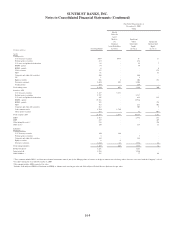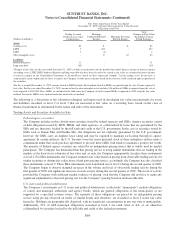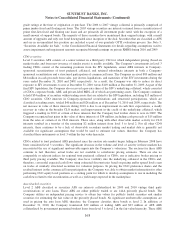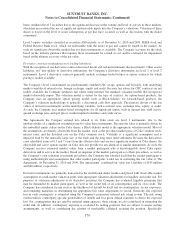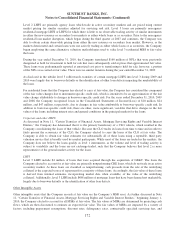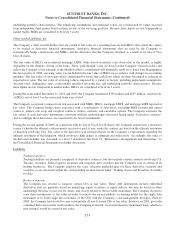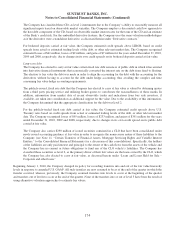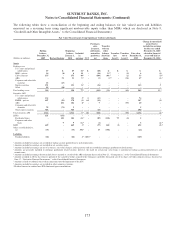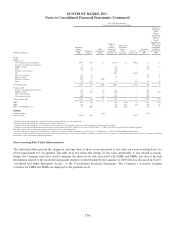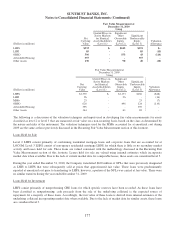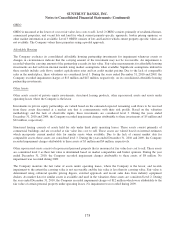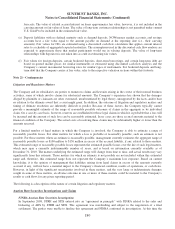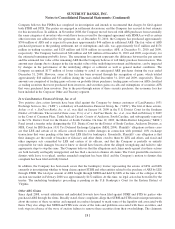SunTrust 2010 Annual Report Download - page 187
Download and view the complete annual report
Please find page 187 of the 2010 SunTrust annual report below. You can navigate through the pages in the report by either clicking on the pages listed below, or by using the keyword search tool below to find specific information within the annual report.
SUNTRUST BANKS, INC.
Notes to Consolidated Financial Statements (Continued)
approved counterparties and exposure limits are defined. Creditworthiness of the approved counterparties is
regularly reviewed and appropriate business action is taken to adjust the exposure to certain counterparties, as
necessary. This approach used to estimate exposures to counterparties is also used by the Company to estimate its
own credit risk on derivative liability positions.
See Note 17, “Derivative Financial Instruments,”to the Consolidated Financial Statements, for additional
information on the Company’s derivative contracts.
Trading loans
The Company engages in certain businesses whereby the election to carry loans at fair value for financial reporting
aligns with the underlying business purposes. Specifically, the loans that are included within this classification are:
(i) loans made in connection with the Company’s TRS business (see Note 17, “Derivative Financial Instruments,” to
the Consolidated Financial Statements for further discussion of this business), (ii) loans backed by the SBA and
(iii) the loan sales and trading business within the Company’s CIB line of business. All of these loans have been
classified as level 2 within the fair value hierarchy, due to the market data that the Company uses in its estimates of
fair value.
The loans made in connection with the Company’s TRS business are short-term, demand loans, whereby the
repayment is senior in priority and whose value is collateralized. While these loans do not trade in the market, the
Company believes that the par amount of the loans approximates fair value and no unobservable assumptions are
made by the Company to arrive at this conclusion. At December 31, 2010, the Company had $972 million of such
short-term loans carried at fair value and none were outstanding at December 31, 2009.
SBA loans are similar to SBA securities discussed herein under “Federal agency securities,” except for their legal
form. In both cases, the Company trades instruments that are fully guaranteed by the U.S. government as to
contractual principal and interest and has sufficient observable trading activity upon which to base its estimates of
fair value.
The loans from the Company’s sales and trading business are commercial and corporate leveraged loans that are
either traded in the market or for which similar loans trade. The Company elected to carry these loans at fair value in
order to reflect the active management of these positions. The Company is able to obtain fair value estimates for
substantially all of these loans using a reputable, third party valuation service that is broadly used by market
participants. While most of the loans are traded in the markets, the Company does not believe that trading activity
qualifies the loans as level 1 instruments within the fair value hierarchy, as the volume and level of trading activity is
subject to variability and the loans are not exchange-traded, such that the Company believes that level 2 is a more
appropriate presentation of the underlying market activity for the loans. At December 31, 2010 and 2009, $381
million and $287 million, respectively, of loans related to the Company’s trading business were outstanding.
Loans and Loans Held for Sale
Residential loans
Current U.S. GAAP generally does not require loans to be measured at fair value on a recurring basis, but does
provide for an election to do so. As such, in the second quarter of 2007, the Company began recording at fair value
certain newly-originated mortgage LHFS based upon defined product criteria. The Company chose to fair value
these mortgage LHFS in order to eliminate the complexities and inherent difficulties of achieving hedge accounting
and to better align reported results with the underlying economic changes in value of the loans and related hedge
instruments. This election impacts the timing and recognition of origination fees and costs, as well as servicing
value. Specifically, origination fees and costs are recognized in earnings at the time of origination. The servicing
value, which had been recorded as MSRs at the time the loan was sold, is now included in the fair value of the loan
and initially recognized at the time the Company enters into IRLCs with borrowers. The Company began using
derivatives to economically hedge changes in servicing value as a result of including the servicing value in the fair
value of the loan. The mark to market adjustments related to LHFS and the associated economic hedges are captured
in mortgage production income.
171





